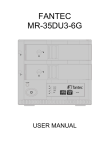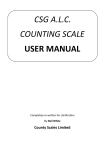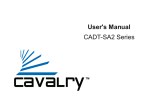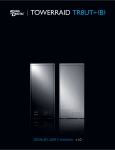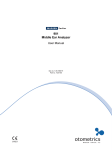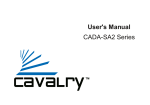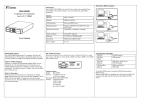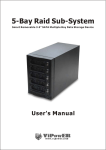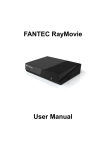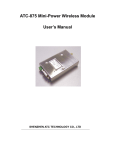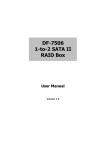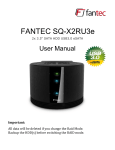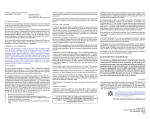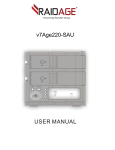Download MANUAL FANTEC MR
Transcript
FANTEC
MR-35DU3
USER MANUAL
1. Product Introduction
MENU
MENÜ ...............................................................................................................................
1
1. Product Introduction...................................................................................................
2
2. Operation......................................................................................................................
2.1 USB Interface...............................................................................................................
2.1.1 JBOD Modus ...........................................................................................................
2.1.2 BIG Modus ...............................................................................................................
2.1.3 RAID0/FAST Modus..................................................................................................
2.1.4 RAID1/SAFE Modus..................................................................................................
2.1.5 Partitioning Volumes..................................................................................................
3
6
6
7
8
9
10
3. NOTE..............................................................................................................................
14
4. Features.........................................................................................................................
4.1 High speed external storage solution, Superspeed ,USB 3.0 5.0Gb/s.........................
4.2 Serial ATA HDD............................................................................................................
4.3. Four Working Modei.....................................................................................................
4.4 Support system Windows /XP/VISTA/7 & MAC OS 9.0 und höher……………………..
4.4.1 System Expansion for Windows................................................................................
14
14
15
15
17
17
5. Package contents ........................................................................................................
18
SATA 2x HDD TO USB 3.0 5.0G interface.
Front
Back
1
Connect to the computer host through USB, and turn on the power
2. Operation
The Hard Disk Installation:Sway from side to side the lock
, and pull the
doorknob to insert 1 or 2 hard disk.Close the doorknob and the installation will be
completed (The step will be represented in terms of following graphs)
Turn the switch to RAID0, LED will keep bright and the host will be entering the
RAID0 active status.
Turn the switch to RAID1, RAID1 LED keep bright, and the host will be entering
the RAID1 active status.
Turn the switch to JBOD, JBOD LED keep bright, and the host will be entering the
JBOD active status.
Turn the switch to BIG, BIG LED will keep bright, the host will be entering the BIG
active status.
sends blue light and has long-lasting bright light, which
Hard disk LED
indicates the hard disk connection is correct.
sends the pink light and does not stop glittering, which
Hard disk LED
indicates the hard disk performing wrong material transmission.
Hard disk LED
sends red light and does not stop glittering, which
indicates the hard disk connection error.
Note:Sway from side to side the lock at the instructed point
which you could
open the doorknob to install/ unload the hard disk. In Contrast, when you sway from
side to side the lock at the instructed point
2
then you may not open it.
3
LED condition:
switch on power and insert two HD in terms of different working pattern
PATTERN
RAID0
RAID1
JBOD
BIG
HDD carries on the self-checking
HDD1 and HDD2 LED glitter in turn
with blue& red lights. Self- checking
completes when LED sends blue
light
HDD1 and HDD2 LED glitter in turn
with blue& red lights. Self- checking
completes when LED sends blue
light
HDD1 and HDD2 LED glitter in turn
with blue& red lights. Self- checking
completes when LED sends blue
light
HDD1 and HDD2 LED glitter in turn
with blue& red lights. Self- checking
completes when LED sends blue
light
Material transmission
Under the material transmission: The
HDD1 and the HDD2 LED glitter with
purple light. The material transmission
completes when LED sends the blue light
Under the material transmission: The
HDD1 and the HDD2 LED glitter with
purple light. The material transmission
completes when LED sends the blue light
Under the material transmission
condition: LED glitters with purple light
while operating different HDD. The
material transmission completes when
LED sends blue light
Under the material transmission: The
HDD1 and the HDD2 LED glitter with
purple light. The material transmission
completes when LED sends the blue light
Switch on power then insertion HD or two HD have a damage in the situation
under the different working pattern the LED condition (HDD1 normal, HDD2 is
unusual, otherwise also establishes)
PATTERN
RAID0
RAID1
JBOD
BIG
4
HDD carries on the self-checking
HDD1 and the HDD2 LED glitter in
turn with blue & red lights.
Selfchecking
completes when the
HDD1 LED sends blue light, and
the HDD2 LED continues glittering
in turn with blue& red lights.
HDD1 and the HDD2 LED glitter in
turn with blue & red lights.
Selfchecking
completes when the
HDD1 LED sends blue light, and
the HDD2 LED continues glittering
in turn with blue& red lights.
HDD1 and the HDD2 LED glitter in
turn with blue & red lights.
Selfchecking
completes when the
HDD1 LED sends blue light, and
the HDD2 LED continues glittering
in turn with blue& red lights.
HDD1 and the HDD2 LED glitter in
turn with blue & red lights.
Selfchecking completes when the
HDD1 LED sends blue light, and
the HDD2 LED continues glittering
in turn with blue& red lights.
Material transmission
Under the material transmission condition: The
HDD1 LED glitters with purple light, and the
HDD2 LED glitters in turn with blue & red lights.
The material transmission completes when
HDD1 LED sends blue light and the HDD2 LED
continue glittering in turn with blue & red lights.
Attention:
1. If you use two HDD simultaneously and discover that the LED1 or LED2
glittering with blue & red lights in turn for a long time. Please check and see if the
HDD has installed correctly.
2. If you simultaneously use two HDD, and the HDD damaged under RAID0,
JBOD, and BIG pattern, the data on the HDD will lose. Under the RAID1 pattern,
you may consider to take out the damaged HDD and replace formatted HDD
instead. The 5744 software “ REBUILDING” function will start recovering and the
data will be recovered.
2.1 USB Interface
2.1.1 JBOD Mode
The two drives were connected to the products HDD1 and HDD2 Connector.
USB&Power Cable were connected;
Opening the power switch, pulling MODE switch to and press
switch, after a few seconds, the computer will automatically capture USB devices
and increased 2 drives(If not drive there, then the hard disk drive management
will re-zoning which format),At the moment you can Operate the disk. Re-zoning
which drives formatted as follows(All information will be eliminated when Format
hard drives).
Click “ ”, right-clicking pop-up menu, click Options “ ”, popup
computer management plan was pop-up as follow:
Under the material transmission condition: The
HDD1 LED glitters with purple light, and the
HDD2 LED glitters in turn with blue & red lights.
The material transmission completes when
HDD1 LED sends blue light and the HDD2 LED
continue glittering in turn with blue & red lights.
Under the material transmission condition: The
HDD1 LED glitters with purple light, and the
HDD2 LED glitters in turn with blue & red lights.
The material transmission completes when
HDD1 LED sends blue light and the HDD2 LED
continue glittering in turn with blue & red lights.
Under the material transmission condition: The
HDD1 LED glitters with purple light, and the
HDD2 LED glitters in turn with blue & red lights.
The material transmission completes when
HDD1 LED sends blue light and the HDD2 LED
continue glittering in turn with blue & red lights.
5
Click “Disks Management” plan:
Right pop-up The additional disks (H :) and the additional disks (I :)' menus,
choose “Delete disk segmentation ”.
Click “Segmentation additional disks”, followed by a clew to operate
2.1.2 BIG Mode
The two drives were connected to the products HDD1 and HDD2 Connector.
USB&Power Cable were connected;
Opening the power switch, pulling MODE switch to BIG and press RESETswitch,
after a few seconds, the computer will automatically capture USB devices.
Click “My Computer”, right-clicking pop-up menu, click Options “manage”, popup
computer management plan was pop-up as follow:
2.1.3 RAID0/ FAST Mode
The two drives were connected to the products HDD1 and HDD2 Connector.
USB&Power Cable were connected;
Opening the power switch, pulling MODE switch RAID0 to and press RESET
switch, after a few seconds, the computer will automatically capture USB devices
and increased 1 drive(If not drive there, then the hard disk drive management will
re-zoning which format),At the moment you can Operate the disk. Re-zoning
which drives formatted as follows(All information will be eliminated when Format
hard drives).
Click “My Computer”, right-clicking pop-up menu, click Options “manage”, popup
computer management plan was pop-up as follow:
Click “Disks Management” plan:
Right pop-up the additional disks (H:)' menus, choose “Delete disk segmentation”.
Click “Segmentation additional disks”, followed by a clew to operate.
Click “Disks Management” plan:
Right pop-up the additional disks ( H:)' menus, choose “Delete disk
segmentation
”.
Click “Segmentation additional disks”, followed by a clew to operate
6
7
2.1.4 RAID1/ SAFE Modus
The two drives were connected to the products HDD1 and HDD2 Connector;
USB&Power Cable were connected;
Opening the power switch, pulling MODE switch to RAID1 and press RESET
switch, after a few seconds, the computer will automatically capture USB devices
and increased 2 drives(If not drive there, then the hard disk drive management
will re-zoning which format),At the moment you can Operate the disk. Re-zoning
which drives formatted as follows(All information will be eliminated when Format
hard drives);
Click “My Computer”, right-clicking pop-up menu, click Options “manage”, popup
computer management plan was pop-up as follow:
2.1.5 Partitioning Volumes
This section explains how to partition volumes after configuring them in the
SteelVine Manager GUI. You must partition volumes for the host computer's
operating system before you can store data on the volumes. Refer to the
operating system's documentation for further guidance.
Partition a Volume
MS Windows
Important: Before reconfiguring a volume, back up your data and delete
previously defined SteelVine Storage Reference Design partitions. If no hard disk
drives are connected to the SteelVine Storage Processor, the SteelVine
Processor device (the " Not Initialized" disk with no capacity allocated to it) will
appear. Do not initialize or modify that device.
1. Right-click the My Computer icon on your desktop and select Manage from the
pop-up window.
Click “Disks Management” plan :
Right pop-up The additional disks ( H:) and the additional disks (F :)' menus,
choose “Delete Disk Segmentation”.
Click “Segmentation additional disks”, followed by a clew to operate
2. Select Disk Management under Storage to open the Windows Disk Manager.
8
9
Every disk should appear with the word “ Basic”, a size value that shows the available
storage capacity, and a status of “ Online”. Instead of Basic, a disk could appear Unknown,
Dynamic, or Not Initialized .
If the disk appears as “ Unknown”, right-click the disk icon and select Write Signature. A
window opens with the selected disk (all Unknown disks may appear in this window). Make
sure the box next to each disk is checked and click OK. The disk should now be marked as
a Basic disk.
If a disk appears as “ Dynamic”, right-click the disk icon, and select Revert to Basic Disk .
Within a few seconds, the disk should be marked as a Basic disk . If a disk is marked “ Not
Initialized ”, right-click the disk icon and select Initialize Disk. An additional dialog box
appears allowing you to select which disks to initialize. Uncheck the SteelVine Processor
Disk item and click OK. Within a few seconds, the selected disk(s) should be marked as a
Basic disk.
3. Right-click the configured disk's unallocated space and select New Partition . If the New
Partition option is not available, select the disk and initialize it first. To do this, right-click on
the disk item and select " Initialize Disk ".
6. Specify the partition size. By default, the partition occupies the entire volume.
Click Next.
4. Click Next to start the Partition Wizard.
7. Assign a drive letter or mount path and click Next.
5. Select the Primary or Extended option and click Next.
10
11
8. Name and format the partition and click .
9. Review the file system settings and click to create the logical partition.
Mac OS X
Important: Before reconfiguring a volume, back up your data and drag the old drive to the
trash to un-mount previously defined SteelVine Storage Reference Design partition. If no
hard drives are connected to the Storage Appliance, the SteelVine Processor disk (8.0 GB
Config Disk Media) will appear. Do not remove or modify that partition. After you configure
and partition the new volumes, restore the backed-up data to the new configuration.
5. Select Mac OS Extended (journaled) from the Format drop-down list.
6. Specify the size of the partition in the Size field.
7. Click the Partition button.
8. Click Partition to acknowledge the warning.
1. Launch Disk Utility from the Application > Utilities folder.
Disk Utility mounts the created partition and represents it with an icon on the desktop. The
icon is labeled with the partition name.
2. Select a configured disk and click the Partition tab. This procedure illustrates the BIG
Storage Policy configuration, which concatenates the capacity of all hard drives connected
to the SteelVine Storage Reference Design.
3. Select 1 Partition from the Volume Scheme drop-down list.
4. Enter a name for the volume in the Name field (such as “My BIG disk”.)
12
3. Note
1. If this product is in use for the first time or the mode (BIG, JBOD, RAID0/FAST,
RAID1/SAFE) is changed, we must initialize and format the HDD before. (All
information will be eliminated when format hard drives)
2. When you need to change different mode (BIG, JBOD, RAID0/FAST,
RAID1/SAFE) you must press the RESET button, so that the enclosure can
distinguish the exact mode.
3. If you require a faster data transfer, RAID0/FAST MODE will be suggested to
use.
4. If you require a higher data security, RAID1/ SAFE MODE will be suggested to
use.
5. If you require a bigger hard disk capacity, BIG MODE will be suggested to use.
4. Features
4.1 High speed external storage solution,. USB 3.0 (5.0 Gb/s).
The FANTEC MR-35DU3 provides the following Serial Advanced Technology
Attachment (SATA) features:
Automatic negotiation between SATA I (1.5Gbps) and SATA II (3.0 Gbps)
Serial ATA 2.5 specification compliance (Gen2m)
Serial ATA Port Multiplier 1.1 specification compliance
For detailed information about SATA technology, refer to the following
13
specifications online:
Serial ATA: High Speed Serialized AT Attachment, Revision 1.0a
Serial ATA II: Extensions to Serial ATA 1.0a, Revision 1.1
Serial ATA II: Port Multiplier, Revision 1.1
The Serial ATA web site is http://www.serialata.org/.
USB Features
The FANTEC MR-35DU3 provides the following Universal Serial Bus (USB)
features:
USB 1.0 and USB 2.0 specification compliance
For detailed information about USB technology, refer to the following
specifications online:
Universal Serial Bus Specification, Revision 1.1
Universal Serial Bus Specification, Revision 2.0
The USB Organization web site is http://www.usb.org/
4.2 Serial ATA HDD
Populated with two Serial ATA (SATA) hard disk drives (HDDs), each unit can
manage as much as 4,000 gigabytes (i.e., 4 terabytes) of data, depending on the
capacity of the hard disk drives that are installed. By combining multiple units in a
daisy-chained hierarchy structure, you can increase the total storage capacity of
your system.
4.3. 4 Arbeits Modis (BIG,JBOD,RAID0/FAST,RAID1/SAFE)
You can configure the FANTEC MR-35DU3 to use any of the following Storage
Policies to map the appliance's physical hard drives to virtual drives that are
visible to the host computer. The virtual drives are called volumes in the GUI. The
host operating system treats each volume as if it were a single physical drive.
This virtualization allows you to overcome restrictions that are imposed by
physical hard drives, such as speed, storage capacity or data storage reliability.
BIG
The BIG storage policy concatenates a series of physical hard drives as a single
large volume; resulting in a seamless expansion of virtual volumes beyond the
physical limitations of singularly connected hard drives. SteelVine BIG storage
policy delivers maximum storage space without a single large capacity and costly
hard drive. Hard drive A and B are concatenated into a single virtual volume in the
Figure below with a storage capacity that is equal to the sum of each of the
physical hard drives A and B.
14
It is also possible to create a BIG volume using only a single hard disk drive
connected to Port 0, and then increase the storage capacity of the volume later by
adding another hard disk drive to Port 1 and pressing the Mode Change pushbutton.
The new disk blocks of Port 1 will be concatenated to the end of the disk
blocks of Port 0, and any data that is stored on the existing BIG volume will be
preserved. However, it is not possible to expand an existing BIG volume by
adding another hard disk drive to Port 0 and still preserve any existing data on
that volume.
JBOD
The JBOD (Just a Bunch of Disks) storage policy enables each hard drive to be
seen separately as one drive. if using a USB host connection. JBOD storage policy is
available in the SteelVine Manager for a standalone (non-cascaded) Storage Processor or
the top-level node of a cascaded configuration, but not for subordinate nodes. Even though
you can use the switch to select JBOD mode. In a JBOD configuration, the
SteelVine Storage Reference Design directly exposes each physical drive.
FAST (RAID0)
The FAST storage policy distributes access across all hard disks, also called
striping (equivalent to RAID 0). FAST presents the best data speed but no data
redundancy. FAST storage policy accelerates hard disk operating speed by using
many disks in parallel. Hard drive data segments are written to different disks
simultaneously which increases performance while sacrificing data redundancy.
To implement the FAST storage policy, the SteelVine Storage Processor creates a
single virtual volume that is striped across both hard drives, with a storage
capacity that is equal to the sum of both hard disk drives.
15
SAFE (RAID1)
The SAFE storage policy stores all data in duplicate on separate drives to protect
against data loss due to drive failure. One drive mirrors the other at all times,
equivalent to RAID 1. Every write operation goes to both drives. SAFE provides
the highest level of data protection for critical data that you cannot afford to lose if
a hard drive fails, but halves the amount of storage capacity because all data
must be stored twice. The resulting storage capacity of the virtual SAFE volume
will be equivalent to the size of one hard drive (if both drives are the same) or the
smaller of the two drives (if they are different).
If one drive fails, the SAFE volume is still usable, but it is in a vulnerable state
because its mirrored hard drive is inaccessible. When the offline drive comes
back online, the appliance begins a rebuild process immediately to restore data
redundancy. A message box appears in the GUI to notify you that a rebuild is in
progress.
Although the volume remains available during the rebuild process, the volume is
susceptible to data loss through damage to the remaining drive until redundancy
is restored at the end of the rebuild and verification process. Host access takes
precedence over the rebuild process. If you continue to use the SAFE volume
during the rebuild, the rebuild process will take a longer time to complete, and the
host data transfer performance will also be affected.
Procedure
Before you can use DiskPart.exe commands on a hard drive disk
partition/volume, you must first list and then select the partition/volume to extend
their capacity to match the virtual hard drives created in the SteelVine Manager
GUI.
1. Open a command prompt window by clicking Start --Run, then entering "cmd"
2. At a command prompt, type “diskpart”.
3. Type” list volume” to display the existing volumes on the computer.
4.4 Support system: Windows 2000/XP/VISTA and MAC OS 9.0 or above version
4.4.1 System Expansion for Windows
Overview
This appendix describes the procedures needed with Microsoft Windows for
expanding file systems that have been created on volumes that have increased in
size, while preserving all of your existing data. After you have added more hard
disk drives to increase the storage capacity of a BIG volume, you must use the
supplemental procedure described below to allow the expanded capacity to be
recognized by the Windows file system.
A command-line utility named "Disk part. exe" ("Disk Partition") enables you to
manage hard disk partitions and volumes. This utility is included as part of
Windows XP Professional Edition, Windows 2003 Server and Windows Vista. For
Windows 2000 or Windows XP Home Edition, you must download the "disk part"
utility from Microsoft's website.
Additional third-party products (such as Norton Partition Magic) are available to
perform similar volume management activities, but those products are very
sophisticated and are not included in this manual.
16
4. Type select volume <volume_number> where “<volume_number>” is number
of the volume that you want to extend. In this case that will be “2”.
5. Type “extend”
6. Type “exit” to quit Diskpart.exe
The volume size will be updated to reflect the expanded physical storage capacity
while maintaining all of the existing data that is stored on the volume.
17
The result of extending the hard disk partition/volume is illustrated below.
Before extend:
2. At a command prompt, type diskpart.
Note: Before the hard drive partition/volume has been extended the “152.67GB
Unallocated” was not accessible for data usage. After using the disk part utility to
extend the hard drive partition/volume capacity, the Windows host side matches
the virtual hard drive partition/volume created in the SteelVine Manager
5. Package contens
FANTEC MR-35DU3
- User manual
- AC Cable
- USB Cable
18











